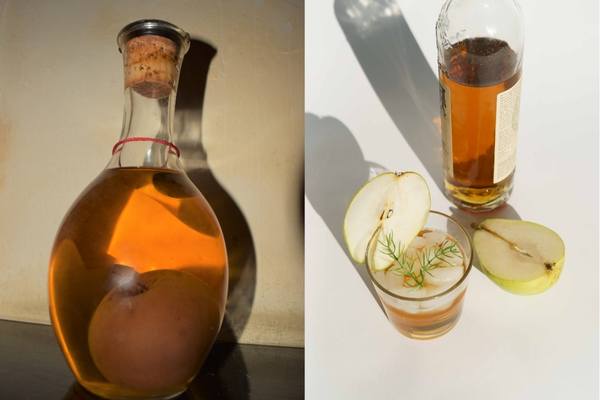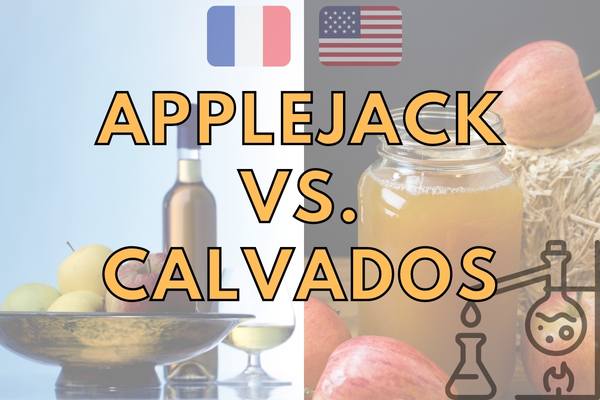If you’re curious about the differences between applejack and calvados, you’ve come to the right place. Both applejack and calvados are popular wines (brandies) distilled from fermented apples – applejack from the US (Pennsylvania) and Calvados is French (Normandy).
The difference in origin naturally also implies a difference in the apple cultivars used, and whereas applejack is made using American cultivars such as Winesap apples, calvados is made using traditional French cider apples such as Rouge Duret, Rambault or Saint Martin.
But the country of origin and the types of apples used is not the only difference – while both are distilled from fermented apple juice, calvados is traditionally distilled using heat whereas applejack is freeze distilled also known as “jacked” (fortified), which gave the applejack drink its name!
While there are also other differences e.g. in the aging process, both are usually aged at least a year.
What makes calvados and applejack different?
Calvados and applejack are both distilled alcoholic beverages, made from apple cider.
Both are distilled and age for a minimum of two years, but applejack is traditionally freeze-distilled rather than heat distilled.
Most calvados brands are also aged for much longer than applejack typically is. Some brands may be aged in large oak vats, while others are blended with other spirits or made entirely from other fruits.
Originally from Normandy, Calvados was created by French distillers who wanted a stronger cider-like drink. The result was a dark, fruity spirit.

Since the 1780s, however, domestic distilleries have been producing fruit-forward brandies. In 1780, the first commercial distillery in the U.S. was founded by Robert Laird, who produced the first apple brandy.
Applejack is often confused with calvados, which is understandable as they may taste quite similar to some people. While it’s similar in alcohol concentration, calvados is often viewed as more potent.
Some would say that Applejack is a worker’s drink of the initial colonizers of the US and that calvados is more sophisticated. But to be honest, they both come in different quality levels!
When it comes down to the details, the two drinks are pretty similar, the main difference being their origin and traditional production method!
What is applejack and how is it made?
Applejack is an apple-based hard liquor with a history dating back to the colonial era. It was one of the first boozes produced in America and became a popular drink among pilgrims.
At this time cider was a non-carbonated drink with around 5% alcohol content. But they quickly learned freeze distillation as a way to make ordinary hard cider into a stronger, more potent, and aromatic drink that containing at least 20% alcohol and typically 40-50%.
The history of applejack goes back to the 17th century. John Chapman planted apple seeds in Massachusetts in 1630.
Just like ordinary hard cider, it was a staple of the colonists and was worth a lot of money as legal tender. It was also used to speculate on real estate and to buy land with fruit-bearing orchards.
Since then, Applejack has come a long way. It is a far cry from the boozy homebrew of the past, where dangerous compounds like acetone, methanol, and other secondary compounds would be concentrated during distillation and sometimes leading to blind people.
The traditional home production of applejack is very simple. Hard cider is enriched with sugar to achieve as high an alcohol percentage as possible. Then the alcohol and flavors are concentrated using a process called freeze distillation – or “jacking” (thereof its name!).
Freeze distillation exploits the fact that all the volatile flavorful compounds (including alcohol!) melt at a lower temperature than does the water in the brew.
After a few freeze-thaw cycles where a good chunk of the ice cube is discarded, you will have yourself a stronger more flavorful drink!
Industrially, it is made by blending at least 20 percent apple wine with a neutral grain spirit and aging it for four years in used bourbon barrels.
It has a mellower flavor than its brandy cousin and is the base for the Jack Rose cocktail, which combines applejack with lime juice.
Applejack is a popular alternative to wine and other spirits. The fermentation process is quick and easy and does not require specialized equipment or expertise.
What does applejack taste like?
There are many types of hard cider that can be used to make applejack, but common to them all is that the main ingredient is apples, which are pretty easy to acquire for most people!
Therefore applejack tastes a lot like apples, or more like a sweet whiskey depending on the brand, degree, and method of distillation, and the aging time and barrels used.
Some ciders are made with culinary apples while others use a blend of bittersweet and sharp apples, which will affect the taste.
If you make your own applejack, you can adjust the strength and aging time as you like.
The type of apple used will also give the cider different aromas and flavors, so be sure to try out a few different kinds to see what you like best!
What is calvados and how is it made?
Calvados is a French apple brandy. It is distilled from Normandy apples and pears. Its history dates back to the 16th century, and it’s widely enjoyed today.
Calvados is a type of brandy that is made from cider. The cider is made from apples of the classical French cider cultivars and is fermented like a French cider. The apple cider is then distilled and aged in oak barrels to make calvados.
The apples used in calvados may for example be:
- Binet Rouge
- Mettais
- Saint Martin
- Frequin
- Rambault
- Rouge Duret
These types of cider apples are classical cider apples and will contribute distinct sour, bitter, and tart taste to the final fermented product. This is considered by many to bring a deeper complexity to calvados compared to traditional applejack, although there is no rule stating the exclusion of these apple cultivars in applejack production.
The process of converting cider to calvados began in 16th century France (Normandy). The first producer was a nobleman named Gilles de Gouberville. In 1606 he organized a group of distillers and formed an official corporation.
They distilled the very popular french ciders rich in tannins and sweetness known from that area of France.
This association laid the foundation for a thriving artisan industry. Today, over 300 producers continue the tradition. The production process begins in the orchard. Trees must be pruned regularly.
They need to be tended to throughout the year, and they need pollinators to help them develop fruit. In addition, there must be grass between the rows, as this preserves the richness of the soil and softens the fall of ripe fruit.

There are many types of calvados available on the market. Selecting one that suits your palate is essential.
The young calvados is characterized by fresh fruit aromas and a distinct apple flavor. On the other hand, the aged calvados are characterized by an apple flavor that is less fruity and more like whiskey in its look and flavor. The flavor of aged calvados is similar to other aged brandies.
The shorter the age, the sweeter the calvados will be. The longer the age, the more complex and whiskey-like the flavor will be. The drink is best served neat or on the rocks, with ice.
Conclusion
So, in conclusion, the main difference between applejack and calvados is their origin and traditional production method!
Applejack and calvados are both distilled alcoholic beverages, made from apple cider. Both are distilled and may be aged, but applejack is traditionally freeze-distilled rather than heat distilled.
Most calvados brands are aged for even longer and typically around 20 years. Some brands may be aged in large oak vats, while others are blended with other spirits or made from pears instead of apples.




